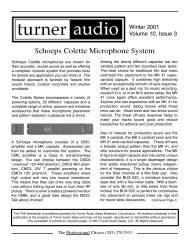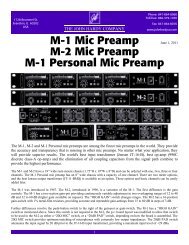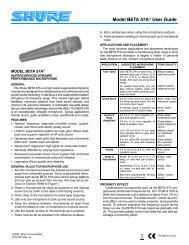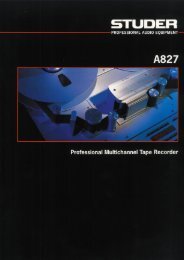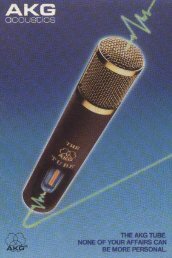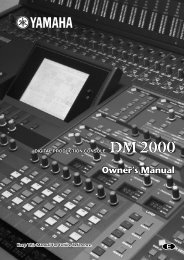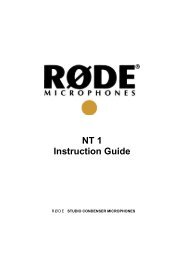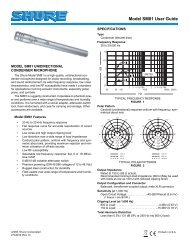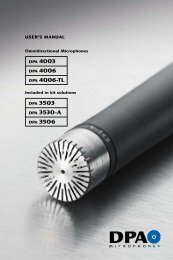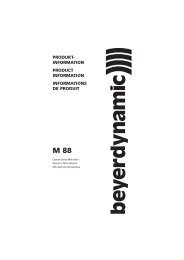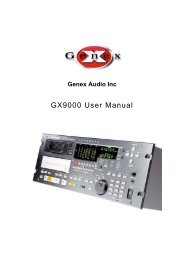Lexicon 480L | PDF - Freeverb3
Lexicon 480L | PDF - Freeverb3
Lexicon 480L | PDF - Freeverb3
Create successful ePaper yourself
Turn your PDF publications into a flip-book with our unique Google optimized e-Paper software.
Bank 17: the Test & Reference Programs<br />
Programs — Bank 17: Oscillator<br />
Programs — Bank 17: Pink Noise<br />
1 100Hz-12dB<br />
LVL DEC FRQ WAV ACC ILEV<br />
-12dB 2 100.00 0 1 -<br />
2 500Hz-17dB<br />
LVL DEC FRQ WAV ACC ILEV<br />
-17dB 2 500.00 0 1 -<br />
3 500Hz-12dB<br />
LVL DEC FRQ WAV ACC ILEV<br />
-12dB 2 500.00 0 1 -<br />
4 1kHz-17dB<br />
LVL DEC FRQ WAV ACC ILEV<br />
-17dB 3 1000.0 0 1 -<br />
5 1kHz-12dB<br />
LVL DEC FRQ WAV ACC ILEV<br />
-12dB 3 1000.0 0 1 -<br />
6 10kHz -12dB<br />
LVL DEC FRQ WAV ACC ILEV<br />
-12dB 4 10000.0 0 1 -<br />
7 30Hz Slate<br />
LVL DEC FRQ WAV ACC ILEV<br />
-12dB 2 30.00 0 1 -<br />
8 A-440 Tuner<br />
LVL DEC FRQ WAV ACC ILEV<br />
-12dB 2 440.00 0 1 -<br />
Program Descriptions<br />
Programs 1-8 are sinewave high accuracy oscillators<br />
with frequency and level settings that match program<br />
names.<br />
9 Pink Noise<br />
LVL<br />
-12dB<br />
Program Description<br />
The Pink Noise program produces filtered noise with<br />
equal energy per octave. The only parameter<br />
provided is the level control, which attenuates from<br />
dBFS and displays attenuation in dB. The program<br />
loads with a value of -12dB from dBFS.<br />
About the Binaural Simulator Program<br />
The Binaural Simulator is designed to alter stereo<br />
recordings for binaural presentation using headphone<br />
monitoring. It includes the ability to add controlled<br />
amounts of early reflections and reverberation, as well<br />
as the ability to independently alter the binaural width<br />
and level of direct sound, reflections, and reverberation.<br />
Although it can be used in all machine configurations,<br />
this program is intended for use in a cascade configuration<br />
with it loaded into Machine B and a reverb or<br />
ambinence program loaded into Machine A.<br />
The synthesis is based on a simple model of the human<br />
head. Information normally fed to one channel is delayed,<br />
low pass filtered, and cross-fed to the opposite<br />
channel. By adjusting delay time and frequency of low<br />
pass filters, apparent binaural width is realistically<br />
varied.<br />
The Binaural Simulator has three independent synthesis<br />
circuits: one of direct sound, one for early reflections,<br />
and one for reverberation. Reverberation generated<br />
in Machine A is fed directly to the rteverberation<br />
simulator. Direct sound feeding <strong>480L</strong> inputs is fed to<br />
the direct sound simulator. The program includes six<br />
independent echo delays, each with variable time and<br />
level control parameters. Their outputs are fed to the<br />
early reflections simulator. A precision mixer provides<br />
level adjustment for each simulator.<br />
14-3


